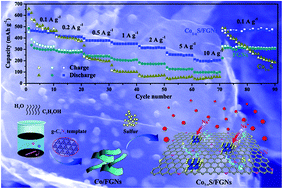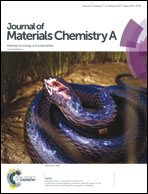A facile sol–gel route to prepare functional graphene nanosheets anchored with homogeneous cobalt sulfide nanoparticles as superb sodium-ion anodes†
Abstract
Hybrid metal sulfides with a graphene matrix is an efficient design to buffer the volume expansion and fragmentation of vulnerable metal sulfides. However, the preparation of graphene oxide is commonly the first step to obtain metal sulfide/graphene composites. In this work, we integrated the preparation of functional graphene nanosheets (FGNs) and the growth of electrochemically active cobalt sulfide (Co1−xS) nanoparticles into the same synthesis procedure by a facile sol–gel method to prepare Co1−xS/FGN nanocomposites. The FGNs not only function as a powerful support for the loading of electrochemically active Co1−xS nanoparticles, which can effectively prevent the re-stacking of the FGNs in turn, but also furnish additional electrochemically active sites for sodium ion storage. Consequently, the Co1−xS/FGN composites delivered a high reversible capacity of 466 mA h g−1 as sodium-ion battery (SIB) anodes, exhibiting a good rate capability with 211 mA h g−1 capacity retained at a large current density of 10 A g−1 and a noticeably improved cycle performance.



 Please wait while we load your content...
Please wait while we load your content...